(完整word版)最全初中英语语法之形容词和副词比较级和最高级[]
- 格式:doc
- 大小:80.01 KB
- 文档页数:9
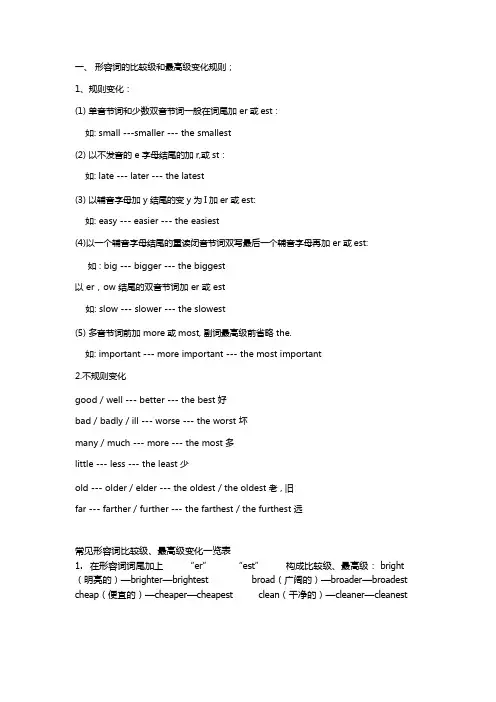
一、形容词的比较级和最高级变化规则;1、规则变化:(1)单音节词和少数双音节词一般在词尾加 er 或 est:如: small ---smaller --- the smallest(2)以不发音的 e 字母结尾的加 r,或 st:如: late --- later --- the latest(3)以辅音字母加 y 结尾的变 y 为 I 加 er 或 est:如: easy --- easier --- the easiest(4)以一个辅音字母结尾的重读闭音节词双写最后一个辅音字母再加 er 或 est:如 : big --- bigger --- the biggest以 er,ow 结尾的双音节词加 er 或 est如: slow --- slower --- the slowest(5)多音节词前加 more 或 most, 副词最高级前省略 the.如: important --- more important --- the most important2.不规则变化good / well --- better --- the best 好bad / badly / ill --- worse --- the worst 坏many / much --- more --- the most 多little --- less --- the least 少old --- older / elder --- the oldest / the oldest 老 , 旧far --- farther / further --- the farthest / the furthest 远常见形容词比较级、最高级变化一览表1.在形容词词尾加上“er”“est”构成比较级、最高级:bright (明亮的)—brighter—brightest broad(广阔的)—broader—broadest cheap(便宜的)—cheaper—cheapest clean(干净的)—cleaner—cleanestclever(聪明的)—cleverer—cleverest cold(寒冷的)—colder—coldestcool(凉的)—cooler—coolest dark(黑暗的)—darker—darkestdeep(深的)—deeper—deepest fast(迅速的)—faster—fastestfew(少的)—fewer—fewest great(伟大的)—greater—greatesthard(困难的,硬的)—harder—hardest high(高的)—higher—highestkind(善良的)—kinder—kindest light(轻的)—lighter—lightestlong(长的)—longer—longest loud(响亮的)—louder—loudest low(低的)—lower—lowest near(近的)—nearer—nearest new(新的)—newer—newest poor(穷的)—poorer—poorest quick(快的)—quicker—quickest quiet(安静的)—quieter—quietest rich(富裕的)—richer—richest short(短的)—shorter—shortest slow(慢的)—slower —slowest small(小的)—smaller—smallestsmart(聪明的)—smarter—smartest soft(柔软的)—softer—softeststrong(强壮的)—stronger—strongest sweet(甜的)—sweeter—sweetesttall(高的)-taller-tallest thick(厚的)—thicker—thickest warm(温暖的)—warmer—warmest weak(弱的)—weaker—weakest young(年轻的)—younger—youngest2.双写最后一个字母,再加上“er”“est”构成比较级、最高级:big(大的)—bigger—biggest fat(胖的)—fatter—fattest hot(热的)—hotter—hottest red(红的)—redder—reddestsad(伤心的)—sadder—saddest thin(瘦的)—thinner—thinnestwet(湿的)—wetter—wettest mad(疯的)—madder—maddest3.以不发音的字母e 结尾的形容词,加上“r”“st”构成比较级、最高级:able(能干的)—abler—ablest brave(勇敢的)—braver—bravest close(接近的)—closer—closest fine(好的,完美的)—finer—finest large(巨大的)—larger—largest late(迟的)—later—latest nice(好的)—nicer—nicest ripe(成熟的)—riper—ripest rude (粗鲁的)—ruder—rudest safe(安全的)—safer—safest strange(奇怪的)—stranger—strangest wide(宽广的)—wider—widest wise(睿智的,聪明的)—wiser—wisest white(白的)—whiter—whitest4.以字母y 结尾的形容词,把y 改为i,再加上“er”“est”构成比较级、最高级:busy(忙碌的)—busier—busiest dirty(脏的)—dirtier—dirtiest dry (干燥的)—drier—driest early(早的)—earlier—earliest easy(容易的)—easier—easiest friendly(友好的)—friendlier—friendliest funny(好玩的)—funnier—funniest happy(开心的)—happier—happiest healthy(健康的)—healthier—healthiest heavy(重的)—heavier—heaviesthungry(饿的)—hungrier—hungriest lazy(懒惰的)—lazier—laziest lucky(幸运的)—luckier—luckiest naughty(调皮的)—naughtier—naughtiest noisy(嘈杂的)—noisier—noisiest pretty(美丽的)—prettier—prettiest silly(傻的)—sillier—silliest spicy(辣的)—spicier—spiciest thirsty (渴的)—thirstier—thirstiest ugly(丑的)—uglier—ugliest4.双音节、多音节形容词,在单词前面加上“more”“most”构成比较级、最高级:afraid(害怕的)—more afraid—most afraid beautiful(美丽的)—more beautiful—most beautiful careful(仔细的)—more careful—most careful cheerful(开心的)—more cheerful—most cheerful crowded(拥挤的)—morecrowded—most crowded dangerous(危险的)—moredangerous—most dangerous delicious(美味的)—moredelicious—most delicious difficult(困难的)—more difficult—most difficult exciting(令人兴奋的)—more exciting—most exciting expensive(昂贵的)—more expensive—mostexpensive famous(著名的)—more famous—most famousfrightened(受惊的)—more frightened—most frightenedfrightening(令人害怕的)—more frightening—most frighteninghard-working(勤奋的)—more hard-working—most hard-workinghelpful(有帮助的)—more helpful—most helpful honest(诚实的)—more honest—most honest important(重要的)—more important—most important interesting(有趣的)—more interesting—most interesting polite(有礼貌的)—more polite—most polite terrible(可怕的)—moreterrible—most terrible tired(累的)—more tired—most tired5.不规则变化的形容词:bad(坏的)—worse—worst good(好的)—better—bestfar(远的)—farther—farthest (far—further—furthest) ill(病的)—worse—worst little(少的)—less—leastmany(多的)—more—most much(多的)—more—mostold(年老的)—older—oldest ( old—elder—eldest) well(好的,身体好的)—better—best一. 写出下列形容词或副词的比较级和最高级.badcleanfamousdirtybigsmallheavylittlehardhappyfarexpensivewelleasywideyoungrudecheapuglybusyoldnoisyinterestinghotcold many brightboring difficultbeautifulthingoodstronghighwarmlateweaktallshortloudlazyquickangrycleversmartlow二、选择填空1.Which does Jimmy like , Chinese or Art?A.wellB. bestC. betterD. much2.The Changjiang River is one of in the world.A. the longest riverB. longest riversC. the longest riversD. longer rivers3.of the two women is Mrs Brown.A.The beautifulB. The more beautifulC. More beautifulD. The most beautiful4.My mooncake is nicer his.A.likeB. withC. forD. than5.You are fatter than .A.heB. hisC. himD. he is tall6.He jumps of the three.A.farB. furtherC. farthestD. furthest7.My hair is longer than .A.my sisterB. KateC. my brother’sD. Lucys’8.There are paper here .Please bring some.A.littleB. lessC. fewerD. a little9.The pen is than that one.A.more cheapB. cheapC. much cheaperD. quite cheaper10.Tom speaks Chinese better than Jimmy.A. moreB. veryC. a lot ofD. much11.There are girls in Class Two than in Class Four.A. moreB. nicestC. mostD. best12.It’s too for you to do that.A. easyB. more dangerousC. harderD. the easiest13.Who has apples now, Jim, Lily or Lucy?A. muchB. biggestC. betterD. the most14.You have more rulers than me. But are nicer than .A.mine, yoursB. mine, yourC. my, yoursD. my, your15.Tingting is than Meimei, but Meimei is than Tingting.A.all, strongerB. taller, strongestC. tallest, strongD. taller, stronger16.Mother is in my family.A. busyB. busierC. the busiestD. more busy17.There are in the park on Sunday.A. more childrenB. a lot of peopleC. much men and womenD. many peoples18.-This blue sweater is too big for me .-Will you please show me a one?A. smallB. smallerC. the smallestD. smallest19.No one is Mary in the class.A. so tallest asB. as taller asC. so high asD. so tall as20. This bike is than that one.A. twenty yuan dearB. twenty yuan dearerC. dear twenty yuanD. dearer twenty yuan[参考答案]CCDDA CDBCD AADAD CBBDB三、用所给词的适当形式填空1.Y our classroom is (wide) and (bright) than ours.2.T here are (few) hours of sunlight a day in winter than in summer.3.Which do you like (well) , maths or chemistry?4.This is the (good) film I have ever seen.5.Africa is the second (large) continent.6.What he said made his mother much (angry) .7.I’m not as (careful) as he.8.We’ve got as (many) books as we need.9.Pratice as (much) as you can.10.They have done (much) work with (little) money.11.You’re the (kind) person I’ve ever met.12.He is (young) than his two sisters.13.The (old) I get, the (strong) I seem to feel.14.The weather is getting (warm) and (warm) .15.Summer is (hot) season of the year.[参考答案] 1. wider, brighter 2. fewer 3. better 4. best 5. largest 6. angry 7. careful 8. many 9. much 10. more, less 11. kindest 12. younger 13. older, stronger, 14. warmer, warmer 15. the hottest。
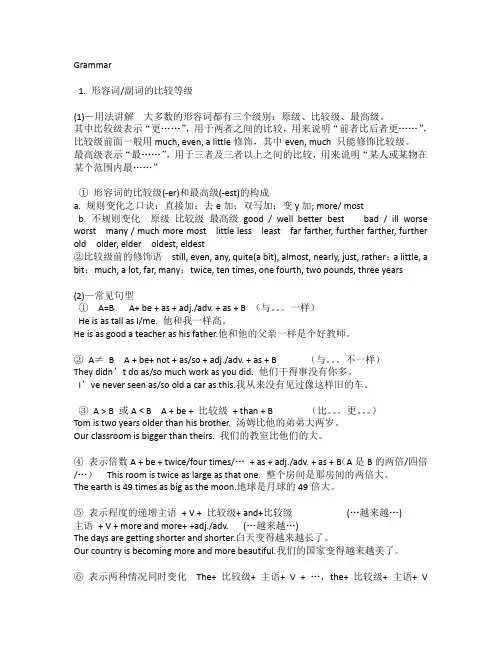
Grammar1. 形容词/副词的比较等级(1)—用法讲解大多数的形容词都有三个级别:原级、比较级、最高级。
其中比较级表示“更……”,用于两者之间的比较,用来说明“前者比后者更……”,比较级前面一般用much, even, a little修饰,其中even, much 只能修饰比较级。
最高级表示“最……”,用于三者及三者以上之间的比较,用来说明“某人或某物在某个范围内最……”①形容词的比较级(-er)和最高级(-est)的构成a. 规则变化之口诀:直接加;去e加;双写加;变y加; more/ mostb. 不规则变化原级比较级最高级good / well better best bad / ill worse worst many / much more most little less least far farther, further farther, further old older, elder oldest, eldest②比较级前的修饰语still, even, any, quite(a bit), almost, nearly, just, rather;a little, a bit;much, a lot, far, many;twice, ten times, one fourth, two pounds, three years(2)—常见句型①A=B A+ be + as + adj./adv. + as + B (与。
一样)He is as tall as I/me. 他和我一样高。
He is as good a teacher as his father.他和他的父亲一样是个好教师。
②A≠ B A + be+ not + as/so + adj./adv. + as + B (与。
不一样)They didn’t do as/so much work as you did. 他们干得事没有你多。
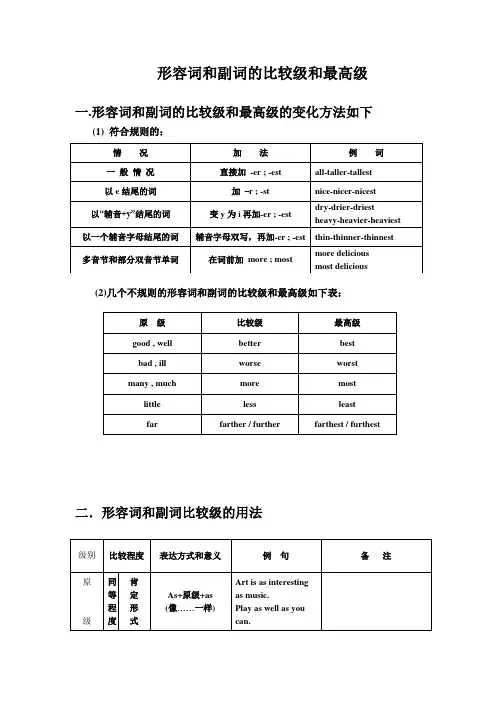
形容词和副词的比较级和最高级一.形容词和副词的比较级和最高级的变化方法如下(1) 符合规则的:(2)几个不规则的形容词和副词的比较级和最高级如下表:二.形容词和副词比较级的用法注意:有些形容词,如 dead, empty, round, sure, woolen 等受本身含义的限制,没有比较级。
例题解析1. He is ________ friends than I.A. much moreB. many moreC. very moreD. too more解析:后面有可数名词复数时,many的比较级形式为many more 修饰。
应选B.2. Which is the _________ country, Japan or Australia?A. more developedB. more developingC. most developedD. most developing解析:两者比较用比较级,表示"发达"用developed, 而developing 是"发展中的" 意思3. There were _______ shops in the city in 1982 than in 1990.A. littleB. fewC. fewerD. less解析:little 不能修饰可数名词,两者比较需用比较级,所以应选C.4. If you are not free today, come another day __________.A. tooB. soC. insteadD. yet解析:instead 作副词用时意为"代替,顶替",表示前面的事情没做,而是做了后面的事。
Instead一般位于句首。
应选C.5.He can't tell us ________, I think.A. important anythingB. anything importantC. important somethingD. something important.解析:不定代词与形容词联用需后置,否定句中应该用anything而不是something. 因此应选B6. The Huang River is the second __________ river in our country.A. longB. longerC. longestD. the longest解析:"定冠词the+ 序数词+ 形容词最高级" 表示"第几大……" 应选C.7. The light in the office wasn't ________for him to read.A. enough brightB. bright enoughC. brightlyD. enough brightly解析:enough修饰名词时可前可后,修饰形容词或副词时,要后置。
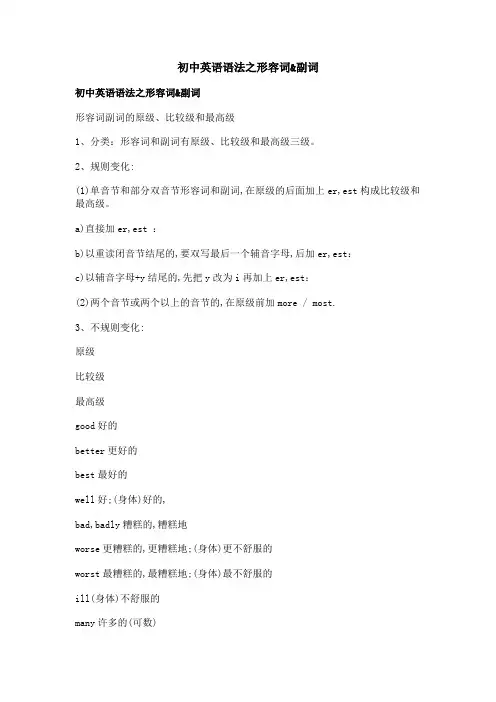
初中英语语法之形容词&副词初中英语语法之形容词&副词形容词副词的原级、比较级和最高级1、分类:形容词和副词有原级、比较级和最高级三级。
2、规则变化:(1)单音节和部分双音节形容词和副词,在原级的后面加上er,est构成比较级和最高级。
a)直接加er,est :b)以重读闭音节结尾的,要双写最后一个辅音字母,后加er,est:c)以辅音字母+y结尾的,先把y改为i再加上er,est:(2)两个音节或两个以上的音节的,在原级前加more / most.3、不规则变化:原级比较级最高级good好的better更好的best最好的well好;(身体)好的,bad,badly糟糕的,糟糕地worse更糟糕的,更糟糕地;(身体)更不舒服的worst最糟糕的,最糟糕地;(身体)最不舒服的ill(身体)不舒服的many许多的(可数)more更多的;更most最多的;最much许多的(不可数);非常little少的less更少的least最少的far远的;远地farther更远的;更远地farthest最远的;最远地further进一步的(地)furthest最深刻的(地)4、形容词和副词的原级、比较级和最高级的用法:(1) 讲述某人/物自身的情况时,用原级。
基本句型是:主语(sb./sth) + 谓语动词+(very/too/so/quite/rather…) + 形容词/副词原级+….如:He is very oldnow. 他现在很老了。
They ran quitefast. 它们跑得相当快。
The weatherlooks rather bad. 天气看上去相当糟。
I am sohappy! 我是如此的快乐!☆表示两者之间没有差别时,使用句型:主语(第一个人物) + 谓语动词 + as + 形容词/副词原级 + as + 第二个人物+….如He is as excited as his younger sister. 他和他妹妹一样兴奋。
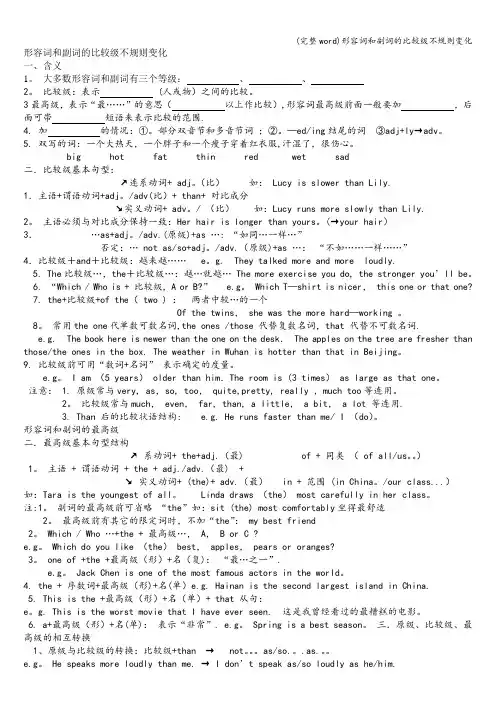
形容词和副词的比较级不规则变化一、含义1。
大多数形容词和副词有三个等级:、、2。
比较级:表示 (人或物)之间的比较。
3最高级,表示“最……”的意思(以上作比较),形容词最高级前面一般要加,后面可带短语来表示比较的范围.4. 加的情况:①。
部分双音节和多音节词;②。
—ed/ing结尾的词③adj+ly→adv。
5. 双写的词:一个大热天,一个胖子和一个瘦子穿着红衣服,汗湿了,很伤心。
big hot fat thin red wet sad二.比较级基本句型:↗连系动词+ adj。
(比)如: Lucy is slower than Lily.1.主语+谓语动词+adj。
/adv(比)+ than+ 对比成分↘实义动词+ adv。
/ (比)如:Lucy runs more slowly than Lily.2。
主语必须与对比成分保持一致:Her hair is longer than yours。
(→your hair)3.…as+adj。
/adv.(原级)+as …: “如同…一样…”否定:… not as/so+adj。
/adv.(原级)+as …:“不如……一样……”4.比较级+and+比较级:越来越…… e。
g. They talked more and more loudly.5. The比较级…,the+比较级…:越…就越… The more exercise you do, the stronger you’ll be。
6. “Which / Who is + 比较级, A or B?” e.g。
Which T—shirt is nicer, this one or that one?7. the+比较级+of the( two ) :两者中较…的一个Of the twins, she was the more hard—working 。
8。
常用the one代单数可数名词,the ones /those 代替复数名词,that 代替不可数名词.e.g. The book here is newer than the one on the desk. The apples on the tree are fresher than those/the ones in the box. The weather in Wuhan is hotter than that in Beijing。
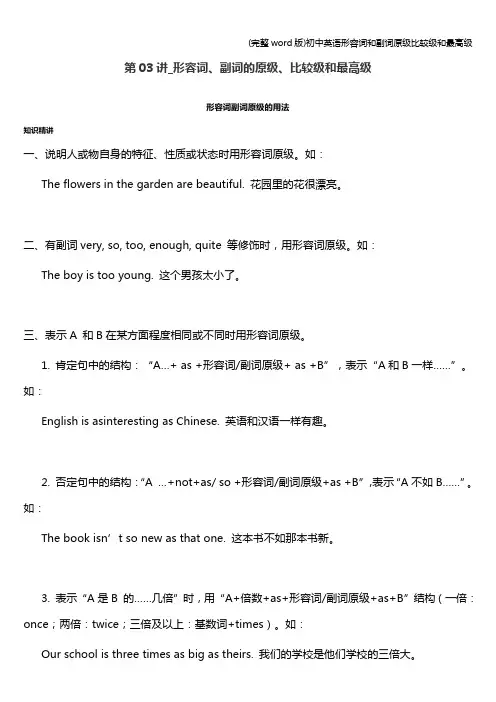
形容词副词原级的用法知识精讲一、说明人或物自身的特征、性质或状态时用形容词原级。
如:The flowers in the garden are beautiful. 花园里的花很漂亮。
二、有副词very, so, too, enough, quite 等修饰时,用形容词原级。
如:The boy is too young. 这个男孩太小了。
三、表示A 和B在某方面程度相同或不同时用形容词原级。
1. 肯定句中的结构:“A…+ as +形容词/副词原级+ as +B”,表示“A和B一样……”。
如:English is asinteresting as Chinese. 英语和汉语一样有趣。
2. 否定句中的结构:“A …+not+as/ so +形容词/副词原级+as +B”,表示“A不如B……”。
如:The book isn’t so new as that one. 这本书不如那本书新。
3. 表示“A是B 的……几倍”时,用“A+倍数+as+形容词/副词原级+as+B”结构(一倍:once;两倍:twice;三倍及以上:基数词+times)。
如:Our school is three times as big as theirs. 我们的学校是他们学校的三倍大。
一、考点:形容词副词不同级别用法的考查较为重要,同学们在学习中要注意辨别不同级别的使用。
二、补充点:否定句的结构中部分双音节和多音节形容词除使用“not …as/ so +形容词/副词原级+ as”结构外,还可使用“less+形容词/副词原级+than”结构。
如:He thinks Chinese is not as interesting as English.= He thinks Chinese is less interesting than English.他认为汉语不如英语有趣。
题模精讲题模一形容词副词原级的用法例1.1、Kate said that she didn’t feel very _________ today.A、gooderB、goodC、niceD、better例1.2、用形容词的适当形式填空。
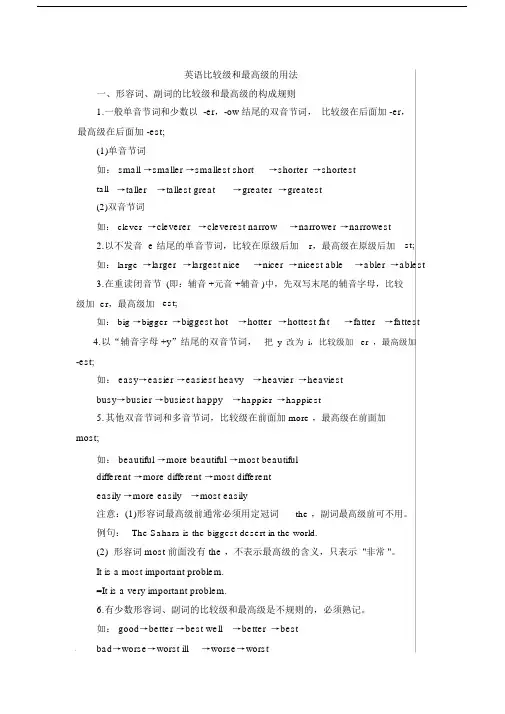
英语比较级和最高级的用法一、形容词、副词的比较级和最高级的构成规则1.一般单音节词和少数以 -er,-ow 结尾的双音节词,比较级在后面加 -er,最高级在后面加 -est;(1)单音节词如: small →smaller →smallest short→shorter→shortesttall→taller→tallest great→greater→greatest(2)双音节词如: clever→cleverer→cleverest narrow→narrower→narrowest2.以不发音 e 结尾的单音节词,比较在原级后加-r,最高级在原级后加-st;如: large→larger→largest nice→nicer→nicest able→abler→ablest3.在重读闭音节(即:辅音 +元音 +辅音 )中,先双写末尾的辅音字母,比较级加 -er,最高级加-est;如: big →bigger→biggest hot→hotter→hottest fat→fatter→fattest4.以“辅音字母 +y”结尾的双音节词,把y改为i,比较级加-er,最高级加-est;如: easy→easier →easiest heavy→heavier→heaviestbusy→busier →busiest happy→happier→happiest5.其他双音节词和多音节词,比较级在前面加more ,最高级在前面加most;如: beautiful →more beautiful →most beautifuldifferent →more different →most differenteasily →more easily→most easily注意:(1)形容词最高级前通常必须用定冠词the ,副词最高级前可不用。
例句:The Sahara is the biggest desert in the world.(2)形容词 most 前面没有 the ,不表示最高级的含义,只表示 "非常 "。
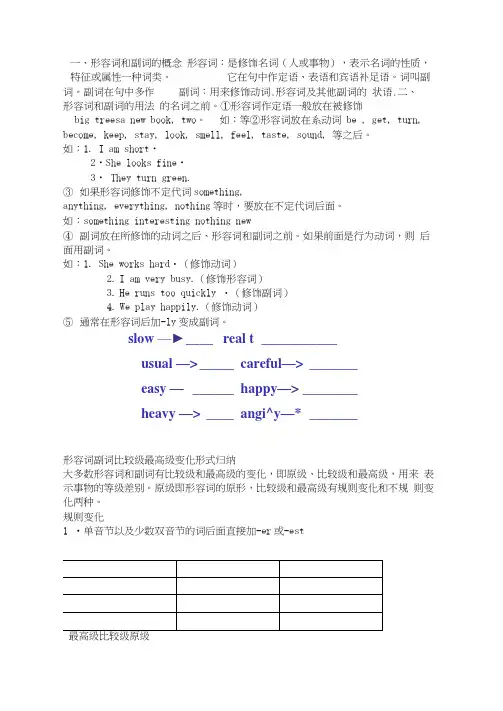
一、形容词和副词的概念形容词:是修饰名词(人或事物),表示名词的性质,特征或属性一种词类。
它在句中作定语、表语和宾语补足语。
词叫副词。
副词在句中多作副词:用来修饰动词.形容词及其他副词的状语.二、形容词和副词的用法的名词之前。
①形容词作定语一般放在被修饰big treesa new book, two。
如:等②形容词放在系动词be , get, turn, become, keep, stay, look, smell, feel, taste, sound, 等之后。
如:1. I am short・2・She looks fine・3・ They turn green.③如果形容词修饰不定代词something,anything, everything, nothing等时,要放在不定代词后面。
如:something interesting nothing new④副词放在所修饰的动词之后、形容词和副词之前。
如果前面是行为动词,则后面用副词。
如:1. She works hard・(修饰动词)2.I am very busy.(修饰形容词)3.He runs too quickly ・(修饰副词)4.We play happily.(修饰动词)⑤通常在形容词后加-ly变成副词。
slow —►____ real t ___________usual —> _____ careful—> _______easy —______ happy—> ________heavy —> ____ angi^y—* _______形容词副词比较级最高级变化形式归纳大多数形容词和副词有比较级和最高级的变化,即原级、比较级和最高级,用来表示事物的等级差别。
原级即形容词的原形,比较级和最高级有规则变化和不规则变化两种。
规则变化1 •单音节以及少数双音节的词后面直接加-er或-est最高级比较级原级tallest taller tallsmartest smarter smartshortestshorter shortesto结尾的双音节形容词末尾加特别提醒:以-y, -er, -ow, leer和healthy, funny, busy, hungry, easy, happy, early, pretty, lazy,如:heavy, dirty, clever, narrow o -stp或2.以不发音的e结尾只加最高级原级比较级nicest nice nicerfinest fine finerlargestlarge larger-est或i,再加-er3•“以辅音字母+y”结尾的词改y为最高比较原easiesteasiereasyprettiestprettierprettyhappiesthappierhappyfunniestfunnierfunnybusiestbusierbusy再加以一个元音加一个辅音字母结尾的重读闭音节词,双写后面的辅音字母,4 •一est最高级原级比较级thinnest thin thinner hottest hotter hotbiggestbigger big等词含有字母组合,且发的是长元音,不用new, few, slow, clean特别提醒: 双un构成的三音节形容词不适合上述情况,特别提醒:以形容前缀unhappy-一unhappier一一unhappiest, untidy一一untidier一一untidiest 如26.以形容词+ly构成的副词要在前面加more, most原级比较级最高级most slowly more slowly slowlymost quickly more quickly quicklymost angrily more angrily angrilymost softly more softly softlymost noisilymore noisilynoisily特另II提醒:early -- e arlier --- earliest7. ill ING分词和ED分词演变过来的形容词(包括不规则动词如know—known)只能加more或most来表示它们的比较级和最高级。

形容词和副词的比较级和最高级(完美版)一、形容词和副词的比较级和最高级的变化方法如下:1) 符合规则的情况:一般情况:直接加-er;-est以e结尾的词:加-r;-st以“辅音+y”结尾的词:变y为i再加-er;-est以一个辅音字母结尾的词:辅音字母双写,再加-er;-est例词:all-taller-tallest,nice-nicer-nicest,dry-drier-driest,heavy-heavier-heaviest,XXX-XXX-XXX2) 几个不规则的形容词和副词的比较级和最高级如下表:原级:good。
well;bad。
ill;many。
much;little;far二、形容词和副词比较级的用法:级别比较程度肯定表达方式和意义例句(备注)原级同等程度 As+原级+as (像……一样) XXX。
not + so (as) +原级+as (不如……那样) English is not so difficult as science。
比较级不同程度 (用于两者比较) 比较级+than (比……) XXX XXX。
比较级前面可以加much。
far。
even。
still。
a lot。
a little。
a bit等程度加深 I like pork better than beef。
最高级同一范围内的最高程度 The +比较级,the +比较级(越……,越……) XXX gets。
the XXX.The XXX reads。
the better their XXX。
This is because reading can XXX.The highest degree of something is expressed using the superlative form。
which is used for three or more things。
Forexample。
"Spring is the best season of the year." Another example is "Lin Tao jumped the farthest of all."When using the superlative form with an adverb。
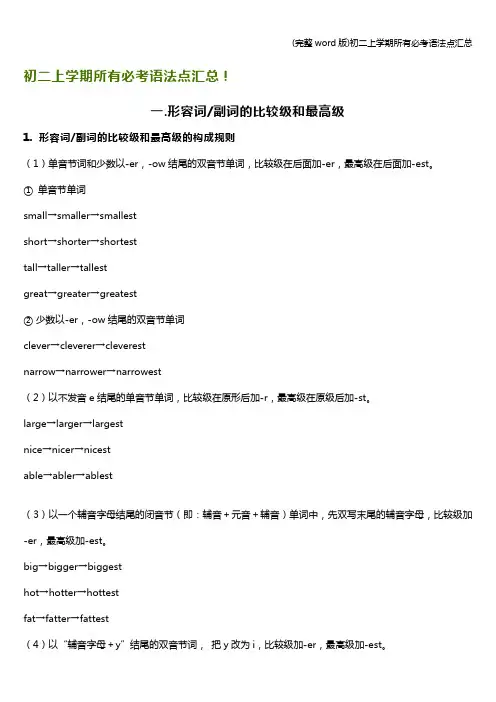
初二上学期所有必考语法点汇总!一.形容词/副词的比较级和最高级1. 形容词/副词的比较级和最高级的构成规则(1)单音节词和少数以-er,-ow结尾的双音节单词,比较级在后面加-er,最高级在后面加-est。
①单音节单词small→smaller→smallestshort→shorter→shortesttall→taller→tallestgreat→greater→greatest②少数以-er,-ow结尾的双音节单词clever→cleverer→cleverestnarrow→narrower→narrowest(2)以不发音e结尾的单音节单词,比较级在原形后加-r,最高级在原级后加-st。
large→larger→largestnice→nicer→nicestable→abler→ablest(3)以一个辅音字母结尾的闭音节(即:辅音+元音+辅音)单词中,先双写末尾的辅音字母,比较级加-er,最高级加-est。
big→bigger→biggesthot→hotter→hottestfat→fatter→fattest(4)以“辅音字母+y”结尾的双音节词,把y改为i,比较级加-er,最高级加-est。
easy→easier→easiestheavy→heavier→heaviestbusy→busier→busiesthappy→happier→happiest(5)其他双音节词和多音节词,比较级在前面加more,最高级在前面加most。
beautiful→more beautiful→most beautifuldifferent→more different→most differenteasily→more easily→most easily(6)有少数形容词、副词的比较级和最高级是不规则的,必须熟记。
good→better→bestwell→better→bestbad→worse→worstill→worse→worstold→older/elder→oldest/eldestmany/much→more→mostlittle→less→leastfar →further/farther→furthest/farthest2. 形容词和副词比较级的用法(1)“甲+be+(倍数)+形容词比较级+than+乙”表示“甲比乙…”或“甲比乙…几倍”。

形容词和副词原级,最高级和比较级用法一、原级的用法1.只能修饰原级的词:very,quite,so,too例如,He is too tired to walk on.他太累了以至于不能再继续走了。
My brother runs so fast that I can‘t follow him.我弟弟跑得那么快以至于我跟不上他。
(1)“甲+be+(倍数)+形容词比较级+than+乙”表示“甲比乙…”或“甲比乙…几倍”例如,Tom is taller than Kate.汤姆比凯特高。
This room is three times bigger than that one.这个房间比那个大三倍。
“甲+实意动词+(倍数)+副词比较级+than+乙”表示“甲比乙…”或“甲比乙…几倍”例如,I got up earlier than my mother this morning.我今天早晨起床比我妈妈还早。
He runs three times faster than his brother.他跑的速度比他弟弟快三倍。
“甲+情态动词+实意动词原形+(倍数)+副词比较级+than+乙”表示“甲比乙…”或“甲比乙…几倍”(2)“甲+be+形容词比较级+than+any other+单数名词(+介词短语)”表示“甲比同一范围的任何一个人/物都……”,含义是“甲最……”。
(运用比较级表达最高级的句型)The Yangtze River is longer than any other river in China.=The Yangtze River is longer than any of the other rivers in China.长江比中国的任何一条其他的河都长。
=The Yangtze River is longer than the other rivers in China.长江比中国的其他所有的河都长。
(一 )比较级和最高级的构成:1 加-er,-est 构成比较级和最高级。
【1】单音节形容词和副词high-higher-highest hard-harder-hardest 【2】以不发音的 -e 结尾的safe-safer-safest late-later-latest【3】辅音字母要双写的情况:【4】以辅音加 -y 结尾的情况dry-drier-driest merry-merrier-merrist 2 加 more,most 构成比较级和最高级。
【1】多音节的形容词和副词expensive-more expensive-most expensivecarefully-more carefully-most carefully【2】由形容词加 -ly 构成的副词slowly-more slowly-most slowlyhighly-more highly-most highly【3】以-ful,-less,-able,-ous,-ive,-ing 等结尾的双音节形容词useless-more useless-most uselessserious-more serious-most seriuos【4】分词形容词 tired,pleased 及 glad,often,real,right,wrong 等单音节形容词tired-more tired-most tiredglad-more glad-most glad( 3 )形容词、副词的比较级和最高级的不规则构成法。
bad/ill/badly-worse-worstmany/much-more-mostlittle-less-leastfar-farther/further-farthest/furthestold-older/elder-oldest/eldest(二) 比较级和最高级的用法1 比较级的表示法:主语 +be +比较级+than …;主语+谓语+比较级+than …( 1 )不同主语的比较:He is two years younger than I.This machine works better than that one.Li Ming studies harder than Wang Ling.( 2 )同一主语不同方面的比较:She is now happier than she has ever been.The exam was easier than we expected.We have had much more rain this year than last year.( 3 )用于修饰比较级的词: even,(very) much,far,a lot,stillThis book is much thicker than that one.He works even harder than before.( 1 ) 形容词和副词最高级的用法三者或三者以上的比较用最高级。
英语语法之形容词比较级和最高级练习题一·形容词的用法一)概念:形容词修饰名词,说明事物或人的性质或特征,通常可将形容词分成性质形容词和叙述形容词两类,其位置不一定都放在名词前面。
1. 直接说明事物的性质或特征的形容词是性质形容词。
【难点】2. 叙述形容词只能作表语,不能做定语修饰名词,所以又称为表语形容词,这类形容词大多数以a开头的形容词都属于这一类。
例如:afraid,asleep, awake,alone等。
形容词在句中的位置:有的形容词放在被修饰的名词之前,称为前置形容词;少数形容词放在被修饰的名词之后,称为后置形容词。
1)当名词被多个前置形容词修饰时,形容词之间有一个先后顺序问题。
一般规则为:(限定词a/an/the)→一般描绘性形容词→表示大小、长短、高低的形容词→表示年龄、新旧的形容词→颜色的形容词→表示国籍、地区、出处的形容词→表示物质、材料的形容词→(名词)。
a beautiful small round old yellow French wooden reading room.以这个例子编一句顺口溜:美小圆旧黄,法木阅览室。
如:There is a famous fine old stone bridge near the village.村子附近有一座著名的漂亮的古代石桥。
练习:Mr Smith bought a___purse for his wife. BA. small black new leatherB. small new black leatherC. leather small black newD. black small new leather二.副词(一)认识副词(后缀)1.-ly, carefully,helpfully,happily(二)以-ly结尾的副词类似hard(adv&adj),hardly(adv)两者意义不同的词组还有意思区别很大的:late迟到,lately最近;pretty=very非常;prettily漂亮地;You have come too late.你来得太晚了。
形容词和副词的比较级和最高级一.形容词和副词的比较级和最高级的变化方法如下(1) 符合规则的:(2)几个不规则的形容词和副词的比较级和最高级如下表:二.形容词和副词比较级的用法注意:有些形容词,如 dead, empty, round, sure, woolen 等受本身含义的限制,没有比较级。
例题解析1. He is ________ friends than I.A. much moreB. many moreC. very moreD. too more解析:后面有可数名词复数时,many的比较级形式为many more 修饰。
应选B.2. Which is the _________ country, Japan or Australia?A. more developedB. more developingC. most developedD. most developing解析:两者比较用比较级,表示"发达"用developed, 而developing 是"发展中的" 意思3. There were _______ shops in the city in 1982 than in 1990.A. littleB. fewC. fewerD. less解析:little 不能修饰可数名词,两者比较需用比较级,所以应选C.4. If you are not free today, come another day __________.A. tooB. soC. insteadD. yet解析:instead 作副词用时意为"代替,顶替",表示前面的事情没做,而是做了后面的事。
Instead一般位于句首。
应选C.5.He can't tell us ________, I think.A. important anythingB. anything importantC. important somethingD. something important.解析:不定代词与形容词联用需后置,否定句中应该用anything而不是something. 因此应选B6. The Huang River is the second __________ river in our country.A. longB. longerC. longestD. the longest解析:"定冠词the+ 序数词+ 形容词最高级" 表示"第几大……" 应选C.7. The light in the office wasn't ________for him to read.A. enough brightB. bright enoughC. brightlyD. enough brightly解析:enough修饰名词时可前可后,修饰形容词或副词时,要后置。
注意:有些形容词,如dead, empty, round, sure, woolen 等受本身含义的限制,没有比较级。
相关结构1)原级比较:肯定句as….as…., 否定句not so / as….as…..2)比较句:比较级+than….或more (less)+adj ….than…..The furniture in this shop is less beautiful than that in that shop.(注意代词that的用法)3)比较级+and+比较级或more and more+比较级“越来越… ”richer and richer, more and more interesting4)The more….., the more…..“越…,越…”The more you look at the picture, the better you will like it.5) 比较级+than any other +n. (单)(适用于范围一致时)(all) other +n.(复)any +n.(单) (适用于范围不一致时)He is taller than any other student / all other students in his class.any student in my class.6) 倍数表达法。
A is three(four, etc.)times the size(height, length etc.)of B.A is three(four, etc.)times as big(high, long, etc.)as B.A is three (four, etc.)times bigger(higher, longer, etc.)than B.用times 表倍数通常用于三倍以上,两倍可以用twice或double.The new building is four times the size (the height)of the old one.这座新楼比那座旧楼大三倍(高三倍)。
可编辑修改精选全文完整版形容词、副词的比较级与最高级用法详解一、形容词、副词比较级、最高级构成大多数的形容词、副词都具有原级、比较级和最高级三种形式。
而形容词、副词的比较级、最高级构成方式分规则变化和不规则变化。
其规则变化的方式详见下面个表:(一)规则变化:(1) 直接在词尾加-er, -est(2) 以不发音字母e 结尾的,在词尾加-r , -st(3)以“辅音字母+y“结尾的,把y 变i,再加-er , -est(4) 以辅音字母结尾的重读闭音节词汇,双写最后一个辅音字母,再加-er , -est(5) 部分双音节和多音节词,在其前加more, most(二)、不规则变化:比较级、最高级具有不规则变化形式的形容词和副词比较少,因此,需要大家逐一认真记忆。
详见下表:【妙记顺口溜】“坏”“病”两“多”和两“好”,一是“远”来,二是“老”,little 是“少”不是“小”。
二、形容词、副词比较级和最高级用法(一)形容词、副词比较级用法形容词、副词的比较级主要对两个的人或物在某种程度、性质上进行比较。
常见的形容词副词比较级用法如下:1.同级比较① A+be/v+as+原级+as+B A和B一样This room is as large as that one .这间房子和那间一样大(形容词)Tom writes as carefully as Kate.汤姆写字跟凯特一样认真。
(副词)②A+be/V+not+as(so)+级+as +B A 不如BTigers aren't as(so) dangerous as lions.老虎不如狮子危险。
(形容词)Mary didn't finish the work as(so) well as Lucy.玛丽完成这项工作不如露西好。
(副词)2.差极比较①A+be/v+比较级+B A比B更......This pen is newer than that one.这支钢笔比那支新。
形容词比较级和最高级的形式一、形容词比较级和最高级的构成形容词的比较级和最高级变化形式规则如下构成法原级比较级最高级①一般单音节词末尾加和②单音节词如果以结尾,只加和③闭音节单音节词如末尾只有一个辅音字母,须先双写这个辅音字母,再加和bighot sadderbiggerhotter saddestbiggesthottest④少数以或结尾的双音节词,末尾加和以结尾的词,如前是辅音字母,把y变成i,再加和,以结尾的词仍只加和CleverNarrowNoble angrierCleverernarrowernobler angriestcleverestnarrowestnoblest⑤其他双音节和多音节词都在前面加单词more和most different moredifferent mostdifferent1) The most high 〔A〕mountain in 〔B〕the world is Mount Everest,which is situated 〔C〕in Nepal and is〔D〕 .2) This house is spaciouser 〔A〕than that 〔B〕white 〔C〕one I bought in Rapid City,South Dakota 〔D〕last year.3) Research in the social 〔A〕sciences often proves difficulter 〔B〕than similar 〔C〕work in the physical 〔D〕sciences.二、形容词比较级或最高级的特殊形式:1. 三个或三个以上音节的形容词只能加more和most只能说more beautiful而不能说beautifuller; 只能说the most beautiful而不能说beautifullest。
但是,以形容前缀结尾的三音节形容词不适合上述情况,如unhappy,untidy,我们可以说:unhappier→unhappiest, untidier→untidiest2. 由分词和分词演变过来的形容词(包括不规则动词如know→known)只能加more或most来表示它们的比较级和最高级more(most) striking, more(most) interesting, more(most) wounded, more(most)worn等。
形容词和副词的比较级和最高级一.形容词和副词的比较级和最高级的变化方法如下(1) 符合规则的:(2)几个不规则的形容词和副词的比较级和最高级如下表:二.形容词和副词比较级的用法注意:有些形容词,如 dead, empty, round, sure, woolen 等受本身含义的限制,没有比较级。
例题解读1. He is ________ friends than I.A. much moreB. many moreC. very moreD. too more解读:后面有可数名词复数时,many的比较级形式为many more 修饰。
应选B.2. Which is the _________ country, Japan or Australia?A. more developedB. more developingC. most developedD. most developing解读:两者比较用比较级,表示"发达"用developed, 而developing 是"发展中的" 意思3. There were _______ shops in the city in 1982 than in 1990.A. littleB. fewC. fewerD. less解读:little 不能修饰可数名词,两者比较需用比较级,所以应选C.4. If you are not free today, come another day __________.A. tooB. soC. insteadD. yet解读:instead 作副词用时意为"代替,顶替",表示前面的事情没做,而是做了后面的事。
Instead一般位于句首。
应选C.5.He can't tell us ________, I think.A. important anythingB. anything importantC. important somethingD. something important.解读:不定代词与形容词联用需后置,否定句中应该用anything而不是something. 因此应选B6. The Huang River is the second __________ river in our country.A. longB. longerC. longestD. the longest解读:"定冠词the+ 序数词+ 形容词最高级" 表示"第几大……" 应选C.7. The light in the office wasn't ________for him to read.A. enough brightB. bright enoughC. brightlyD. enough brightly解读:enough修饰名词时可前可后,修饰形容词或副词时,要后置。
应选B.8. There was an accident at the corner. ________, the girl wasn't _________hurt.A. luckily, badlyB. luck, hardlyC. Lucky, heavilyD. Lucky, strongly解读:第一空修饰全句需用副词,第二空修饰形容词hurt也要用副词,因此选A.9. You must keep your eyes _________ when you do eye exercises.A. closeB. openC. closedD., opened解读: 此处需用形容词做宾语补足语。
应选C.10. Five days has passed , but I haven't finished half of the work. ________,A. alreadyB. stillC. tooD. yet解读:already 与yet 都可用于现在完成时态。
Already常用于肯定句,而yet 常用与否定句。
应选D.三.形容词副词比较级最高级的其他用法(1)和冠词连用the +形容词原级+v(复),指一类人或物the +形容词比较级,指两者中“较…的”的那一个,eg. the younger of the twoa/ an +形容词比较级eg. The pen is expensive. I want a cheaper one.( a) +most+形容词最高级“非常…”eg. a most beautiful city( 2 ) 相关结构1)原级比较:肯定句as….as…., 否定句not so / as….as…..2)比较句:比较级+than….或more (less) ….than…..The furniture in this shop is less beautiful than that in that shop.(注意代词that的用法)3)比较级+and+比较级或more and more+比较级“越来越… ”richer and richer, more and more interesting4)The more….., the more…..“越…,越…”The more you look at the picture, the better you will like it.5) 比较级+than any other +n. (单)(适用于范围一致时)(all) other +n.(复)any +n.(单) (适用于范围不一致时)He is taller than any other student / all other students in his class.any student in my class.6) 倍数表达法。
A is three(four, etc.)times the size(height, length etc.)of B.A is three(four, etc.)times as big(high, long, etc.)as B.A is three (four, etc.)times bigger(higher, longer, etc.)than B.用times 表倍数通常用于三倍以上,两倍可以用twice或double.The new building is four times the size(the height)of the old one.这座新楼比那座旧楼大三倍(高三倍)。
Asia is four times as large as Europe.亚洲比欧洲大三倍。
Your school is three times bigger than ours.你们的学校比我们的学校大三倍。
7) more…than…结构,其意往往是…rather than…,可译为“是……而不是……”或颠倒词序译作“与其说是……,不如说是……”。
That little girl is more tired than hungry. 那个小姑娘是累了而不是饿了。
She is more a mother than a wife或She is more of a mother than a wife.她是贤妻,更是良母。
8) A is to B what C is to D A和B的关系就像C和D的关系Air is to man what water is to fish. 空气对于人类就像水和鱼的关系。
9) no more than= only “只不过”,言其少not more than=at most “不多于”,“至少”,指事实。
no more …than… 和…一样不… 如单音节使用比较级形式not more…than… 不比…更…no less than= as much as “多达”no fewer than= as many as例:I have no more than five yuan in my pocket. 我口袋里的钱只不过5元。
I have not more than five yuan in my pocket. 我口袋里的钱不多于5元。
He is no richer than I.他和我一样穷。
He is no less determined than you. 他的决心不亚于你。
(no less determined than等于“其决心不亚于你”,言其大)He is not less determined than you. 他的决心不比你小。
(not less determined than等于“其决心不小于”,无言其大或小的含义)10) 最高级+of/ in/ among….He is the tallest of the three/ among them/ in is class.四.相关词语辨析1.very 和muchA)very修饰形容词、副词的原级;much修饰比较级;修饰动词用much或very much , eg. I very like English.(×),因改为:I like English very much.B)表示状态的过去分词前用very。
a very frightened boy, a very tired child .一般的情况下,以-ed结尾的分词多用much、very much / greatly等修饰。
如:We were greatly /much shocked by the news about Tom..C)已转化为形容词的现在分词前用very。
如:very interesting / worrying / excitingD)too前用much/ far ,不用very。
You are much / far / a lot too nice.另外,在too many / much, too few / little前用far。
We’ve got far too many eggs and far too few egg cups.E)还有修饰词既不用very,也不用much.eg. be well worth doing, be well above the tree2. so和suchA)so … that … 与such … that … 的区别。
so + 形容词/ 副词+ that …so + 形容词+ a(n)+ 单数可数名词+ that …so + many / much / little / few + 名词+ that …such + a(n)+ 形容词+单数可数名词+ that …such + 形容词+ 不可数名词+ that …such + 形容词+ 复数名词+ that …注意:但当little表示“小”时用such。